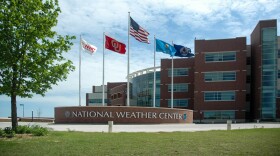Meteorologists are really good at understanding all sorts of complicated weather-related jargon. But when severe storms are in the forecast, it’s important to communicate those threats in a way that people can easily understand.
The National Weather Service has been testing a new, simpler approach in different parts of the country, and last week, they introduced their system to Oklahoma.
Erin Wolfe works on the south side of the University of Oklahoma campus in Norman, just 100 yards from the National Weather Center. When a bad storm came through the city a couple years ago, she thought she was prepared.
“I had been watching the Norman Weather Forecasting Office, their website, refreshing it, looking at all the warnings, and there was just a severe thunderstorm warning,” Wolfe said.
She had a meeting on the other side of campus that afternoon, so she decided to drive over to a parking garage to protect her car from hail damage.
“When I got about a block away from my office, I heard a noise and turned my radio and rolled down the windows and it was a tornado siren,” Wolfe said.
So she turned around and took shelter at her office while the severe weather passed. But she says more information at the time would’ve been useful.
“If I knew that there was any tornadic activity with that storm, or if there was the possibility of tornadic activity, I would've stayed here and sheltered. Or I would've found a shelter to go to instead of just taking off in my car,” she said.
Wolfe’s situation is not uncommon. When it comes to tornado warnings, more information is almost always better.
And with new high-tech equipment, National Weather Service Meteorologist Dave Andra says forecasters can now be more precise.
“It evolved from tornado events and lessons learned from other areas of the National Weather Service and other parts of the country and our recognition that with new radar technology, good spotter information, we could probably add a little bit more information to what had basically been the same warning type of information that had been 25 years unchanged,” Andra said.
These so-called impact based warnings are intended to give people a better idea of the types of hazards they could encounter. So, for example, a new warning might read: “Mobile homes will be damaged or destroyed. Damage to roofs, windows and vehicles will occur.”
And that’s more information than the Weather Service has provided in the past. The change was made with broadcasters and emergency managers in mind.
“I look at the product and I can see the benefit from my perspective as that it has more information,” Frank Barnes, the emergency manager for Oklahoma City said.
“And again, more information that you can push out to the public so that they can make their decisions is a good thing,” Barnes said.
He says for him, a tornado warning is a tornado warning regardless of debris possibilities. But it’s helpful for people who wait to hear a siren before entering a storm shelter or those who want more information about possible damage, like first responders.
Meteorologist Dave Andra is excited about the possibilities this new technology provides.
“We can now see the debris clouds that tornadoes generate. They have a very unique signature in the radar data and we can tell with confidence where damage is occurring, where we were never able to do that before,” Andra said.
Roughly one third of forecast offices currently use impact based warnings. Andra says if the program continues to show success, the National Weather Service could expand this system to the rest of the country over the next few years.
_______________________
Ahead of the Storm: The Oklahoma Tornado Project stories are produced by KGOU News, with funding from the Corporation for Public Broadcasting. Reports may be used in any media with appropriate credit given to KGOU and CPB. For details, refer to our Terms of Use.







